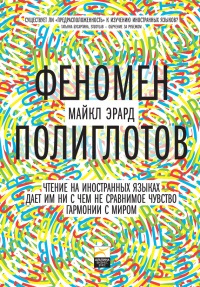Читать книгу "Как рождаются эмоции. Революция в понимании мозга и управлении эмоциями - Лиза Фельдман Барретт"
Шрифт:
Интервал:
Закладка:
Barbas, Helen. 2015. “General Cortical and Special Prefrontal Connections: Principles from Structure to Function.” Annual Review of Neuroscience 38: 269–289.
Barbas, Helen, and Nancy Rempel-Clower. 1997. “Cortical Structure Predicts the Pattern of Corticocortical Connections.” Cerebral Cortex 7 (7): 635–646.
Bargmann, C. I. 2012. “Beyond the Connectome: How Neuromodulators Shape Neural Circuits.” Bioessays34 (6): 458–465.
Barrett, Deborah. 2012. Paintracking: Your Personal Guide to Living Well with Chronic Pain. New York: Prometheus Books.
Barrett, Lisa Feldman. 2006a. “Are Emotions Natural Kinds?” Perspectives on Psychological Science1 (1): 28–58.
——— . 2006b. “Solving the Emotion Paradox: Categorization and the Experience of Emotion.” Personality and Social Psychology Review 10 (1): 20–46.
——— . 2009. “The Future of Psychology: Connecting Mind to Brain.” Perspectives on Psychological Science 4 (4): 326–339.
——— . 2011a. “Bridging Token Identity Theory and Supervenience Theory Through Psychological Construction.” Psychological Inquiry 22 (2): 115–127.
——— . 2011b. “Was Darwin Wrong about Emotional Expressions?” Current Directions in Psychological Science 20 (6): 400–406.
——— . 2012. “Emotions Are Real.” Emotion 12 (3): 413–429.
——— . 2013. “Psychological Construction: The Darwinian Approach to the Science of Emotion.” Emotion Review 5: 379–389.
Barrett, Lisa Feldman, and Moshe Bar. 2009. “See It with Feeling: Affective Predictions During Object Perception.” Philosophical Transactions of the Royal Society B: Biological Sciences 364 (1521): 1325–1334.
Barrett, Lisa Feldman, and Eliza Bliss-Moreau. 2009a. “Affect as a Psychological Primitive.” Advances in Experimental Social Psychology 41: 167–218.
——— . 2009b. “She’s Emotional. He’s Having a Bad Day: Attributional Explanations for Emotion Stereotypes.” Emotion 9 (5): 649–658.
Barrett, Lisa Feldman, James Gross, Tamlin Conner Christensen, and Michael Benvenuto. 2001. “Knowing What You’re Feeling and Knowing What To Do About It: Mapping the Relation Between Emotion Differentiation and Emotion Regulation.” Cognition and Emotion 15 (6): 713–724.
Barrett, Lisa Feldman, Kristen A. Lindquist, Eliza Bliss-Moreau, Seth Duncan, Maria Gendron, Jennifer Mize, and Lauren Brennan. 2007. “Of Mice and Men: Natural Kinds of Emotions in the Mammalian Brain? A Response to Panksepp and Izard.” Perspectives on Psychological Science 2 (3): 297–311.
Barrett, Lisa Feldman, Kristen A. Lindquist, and Maria Gendron. 2007. “Language as Context for the Perception of Emotion.” Trends in Cognitive Sciences 11 (8): 327–332.
Barrett, Lisa Feldman, Batja Mesquita, and Maria Gendron. 2011. “Context in Emotion Perception.” Current Directions in Psychological Science 20 (5): 286–290.
Barrett, Lisa Feldman, Lucy Robin, Paula R. Pietromonaco, and Kristen M. Eyssell. 1998. “Are Women the ‘More Emotional’ Sex? Evidence from Emotional Experiences in Social Context.” Cognition and Emotion12 (4): 555–578.
Barrett, Lisa Feldman, and James A. Russell. 1999. “Structure of Current Affect: Controversies and Emerging Consensus.” Current Directions in Psychological Science 8 (1): 10–14.
——— , eds. 2015. The Psychological Construction of Emotion. New York: Guilford Press.
Barrett, Lisa Feldman, and Ajay B. Satpute. 2013. “Large-Scale Brain Networks in Affective and Social Neuroscience: Towards an Integrative Functional Architecture of the Brain.” Current Opinion in Neurobiology23 (3): 361–372.
Barrett, Lisa Feldman, and W. Kyle Simmons. 2015. “Interoceptive Predictions in the Brain.” Nature Reviews Neuroscience 16 (7): 419–429.
Barrett, Lisa Feldman, Michele M. Tugade, and Randall W. Engle. 2004. “Individual Differences in Working Memory Capacity and Dual-Process Theories of the Mind.” Psychological Bulletin 130 (4): 553–573.
Barsalou, Lawrence W. 1985. “Ideals, Central Tendency, and Frequency of Instantiation as Determinants of Graded Structure in Categories.” Journal of Experimental Psychology: Learning, Memory, and Cognition11 (4): 629–654.
——— . 1992. Cognitive Psychology: An Overview for Cognitive Scientists. Mawah, NJ: Lawrence Erlbaum.
——— . 1999. “Perceptual Symbol Systems.” Behavioral and Brain Sciences 22 (4): 577–609.
——— . 2003. “Situated Simulation in the Human Conceptual System.” Language and Cognitive Processes 18: 513–562.
——— . 2008a. “Cognitive and Neural Contributions to Understanding the Conceptual System.” Current Directions in Psychological Science 17 (2): 91–95.
——— . 2008b. “Grounded Cognition.” Annual Review of Psychology 59: 617–645.
——— . 2009. “Simulation, Situated Conceptualization, and Prediction.” Philosophical Transactions of the Royal Society B: Biological Sciences 364 (1521): 1281–1289.
Barsalou, Lawrence W., W. Kyle Simmons, Aron K. Barbey, and Christine D. Wilson. 2003. “Grounding Conceptual Knowledge in Modality-Specific Systems.” Trends in Cognitive Sciences 7 (2): 84–91.
Bartal, Inbal Ben-Ami, Jean Decety, and Peggy Mason. 2011. “Empathy and Pro-Social Behavior in Rats.” Science 334 (6061): 1427–1430.
Beard, Mary. 2014. Laughter in Ancient Rome: On Joking, Tickling, and Cracking Up. Berkeley: University of California Press.
Bechara, Antoine, Daniel Tranel, Hanna Damasio, Ralph Adolphs, Charles Rockland, and Antonio R. Damasio. 1995. “Double Dissociation of Conditioning and Declarative Knowledge Relative to the Amygdala and Hippocampus in Humans.” Science 269 (5227): 1115–1118.
Becker, Benjamin, Yoan Mihov, Dirk Scheele, Keith M. Kendrick, Justin S. Feinstein, Andreas Matusch, Merve Aydin, Harald Reich, Horst Urbach, and Ana-Maria Oros-Peusquens. 2012. “Fear Processing and Social Networking in the Absence of a Functional Amygdala.” Biological Psychiatry 72 (1): 70–77.
Becquet, Celine, Nick Patterson, Anne C. Stone, Molly Przeworski, and David Reich. 2007. Genetic Structure of Chimpanzee Populations. PLOS Genetics 3 (4): e66. doi:10.1371/journal.pgen.0030066.
Beggs, Simon, Gillian Currie, Michael W. Salter, Maria Fitzgerald, and Suellen M. Walker. 2012. “Priming of Adult Pain Responses by Neonatal Pain Experience: Maintenance by Central Neuroimmune Activity.” Brain 135 (2): 404–417.
Bekoff, Marc, and Jane Goodall. 2008. The Emotional Lives of Animals: A Leading Scientist Explores Animal Joy, Sorrow, and Empathy—and Why They Matter. Novato, CA: New World Library.
Внимание!
Сайт сохраняет куки вашего браузера. Вы сможете в любой момент сделать закладку и продолжить прочтение книги «Как рождаются эмоции. Революция в понимании мозга и управлении эмоциями - Лиза Фельдман Барретт», после закрытия браузера.




